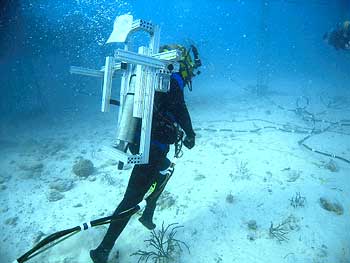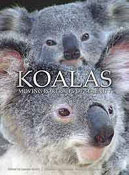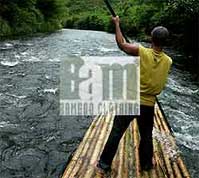Interview with NASA's NEEMO crew
Four astronauts turned aquanauts are living 60 feet beneath the ocean on a coral reef off Florida's Key Largo. They are there as the crew of the NASA Extreme Environment Mission Operations , NEEMO. Their task is to live and learn in an environment as remote and extreme as any found in space. What these scientists learn may one day help us cope with environmental disasters like Hurricane Katrina.

Mission Commander Dr Dave Williams of the Canadian Space Agency and the other four aquanauts: Astronaut Pilot USAF, Colonel Ronald Garan, Mission Specialist Dr Timothy Broderick and Astronaut Mission Specialist Nicole Stott have been living in the underwater sea lab Aquarius since April 3. They return to earth's surface today after spending 18 days underwater.
We spoke with the crew of NEEMO 9 by phone on Tuesday, May 18th.
Greener: Good afternoon. Dr Williams, you are a physician and astronaut, now aquanaut and you were a Mission Specialist aboard the Space Shuttle Columbia during the 16-day flight, called Neurolab. The first question I suppose our readers will ask is, what does living underwater have to do with space exploration, particularly how are these extreme but very different environments analogous?
Dr. Williams: Actually, the two environments are very analogous. In one situation, here underwater, we are as isolated from air and the other necessities of life as we were on Nuerolab. Yes, we flew a 16-day mission and here, we are 18 days on Aquarius, which does not have the same storage space. So, re-supply of consumables like water and food is part of the mission to simulate isolation, as we would experience it in actual space flight. We can use this undersea habitat platform to drive technology and manage hardware problems. Generally, it is a very worthwhile research platform.
We have to be constantly aware of our surrounding and self-reliant in all things so, what we have in Aquarius is as near a perfect lab as we can have on earth to test those parameters.
For instance, when we go outside the habitat to conduct our “sea walks” and do those experiments we are able to add weights to the body-analog to adjust our buoyancy to, for instance, zero gravity level which simulates outer space or we can add weights to more closely mimic the Moon’s gravity, or Mars’. This will help us make decisions about how we would technically proceed with exploration during space flights in the future, and this is driving new technologies such as those that will be bringing humans to the moon.
Greener: Dr Broderick, you are also a physician and surgeon. What is your role on board Aquarius and what does NASA hope to learn from the experiment, specifically what medical technologies are being developed?
Dr Broderick: As a surgeon, my role is that of mission specialist and crew medical officer. I am mainly on board as a medical/technical researcher and crewmember. The mission, from a medical technology standpoint, is largely based on partnerships between NASA and NOAA - which operates Aquarius - the military: U.S. Army and Air Force, Canadian companies and universities in Canada and the U.S. as well, which form a collaborative to develop robotic telesurgery/and medical telementoring techniques that can be employed clinically, here under sea and wirelessly from Ontario Canada by Dr Mehran Anvari.
For this mission aboard Aquarius we have added an artificial time lag, which represents the lag time to communicate from Earth to the Moon. This is the first time this has been done and strongly suggests we could anticipate having expert medical care for astronauts in the future, away from Earth.
Greener: What you’re saying then is that on future missions to the Moon and perhaps Mars, these technologies for remotely controlled robotic surgery might be successfully implemented.
Dr. Broderick: Well, yes and no. we don’t know yet what are the limits of ground based, time lagged, telesurgical techniques and the clinical outcome for astronaut patients. We are evaluating that now with these experiments. Communication to Mars is much longer and more difficult – some techniques that could be used to combat that latency with hardware and software procedures can be more easily addressed and demonstrated in this mission.
Greener: Colonel Garan, our readers cannot actually see your habitat underwater but we have satellite imagery , which shows your location on the edge of the continental shelf. What is the terrain like there and in particular, what experiments is NEEMO conducting outside Aquarius? What do you hope to learn about exploration techniques that will be valuable to future NASA missions on the Moon and Mars?
Colonel Garan: Habitat sits on the ocean floor in 60 feet of water in a deep-water coral reef. Just to the east, the reef drops off and gets very deep. This area will fall under exploration during the entire 18 days and, as we explore outside the habitat, it will all relate directly to actual space exploration. We also have a process, which applies to construction tests, and cooperative work techniques, such as tracking space walking crewmembers outside of the habitat. When go back to Moon, we plan to go further away from habitat and have larger crews. Objectives will be much more challenging and these experiments will help us learn how best to proceed as we explore extreme environments on the moon and Mars.
Greener: So, you want to know if, during future explorations, astronauts will have the option to keep crew members in the habitat while the other members of the crew are outside and would they be able to assist one another.
Colonel Garan: During Apollo, astronaut crews had to depressurize the capsule every time someone went outside to the Moon’s surface, we may not want to operate like that on the moon, going back there. We might have a decompression airlock that would enable crewmembers to stay aboard in a full atmosphere environment while other members exited the habitat through the airlock.
Greener: Which reminds me, I read about an open water hatch on Aquarius called, was it a “Moon Pool,” used to exit the habitat. We are an environmental magazine and I’m sure that our readers would like to understand how this opening in the habitat to the sea and the coral reef operates.
Colonel Garan: We call it a wet porch. Ambient water pressure at any depth of the ocean is equal in all directions so air pressure inside the habitat keeps water from coming in. It’s like inverting an empty glass in water; the trapped air keeps the water out. When they want to go outside on “sea walks,” crew members walk to one side, step into wet porch and they are outside of the vehicle. This allows the vehicle to remain pressurized at all times while crewmembers who remain inside are quite comfortable.
Dr Williams: One thing, you know, that is most noticeable and I remember distinctly from the orbital flight, is that when you are on the shuttle looking down at earth orbiting every 90 minutes, you see how beautiful and how very fragile our planet looks. At that moment, you cannot help but understand the concept of planetary stewardship. Earth is a small planet and we need to take care of our environment, including the oceans here on earth.
Greener: Well, we are out of time and you have actually anticipated my next question, which was to have been to the fourth member of the NEEMO mission crew, Nicole Stott who as a long-time certified diver is very familiar with the ocean environment.
I want to thank all of you and wish you the best in these last two days of your mission.
Take a virtual tour of the Aquarius Sea Lab
by Harlan Weikle
Greener Magazine

Mission Commander Dr Dave Williams of the Canadian Space Agency and the other four aquanauts: Astronaut Pilot USAF, Colonel Ronald Garan, Mission Specialist Dr Timothy Broderick and Astronaut Mission Specialist Nicole Stott have been living in the underwater sea lab Aquarius since April 3. They return to earth's surface today after spending 18 days underwater.
We spoke with the crew of NEEMO 9 by phone on Tuesday, May 18th.
Greener: Good afternoon. Dr Williams, you are a physician and astronaut, now aquanaut and you were a Mission Specialist aboard the Space Shuttle Columbia during the 16-day flight, called Neurolab. The first question I suppose our readers will ask is, what does living underwater have to do with space exploration, particularly how are these extreme but very different environments analogous?
Dr. Williams: Actually, the two environments are very analogous. In one situation, here underwater, we are as isolated from air and the other necessities of life as we were on Nuerolab. Yes, we flew a 16-day mission and here, we are 18 days on Aquarius, which does not have the same storage space. So, re-supply of consumables like water and food is part of the mission to simulate isolation, as we would experience it in actual space flight. We can use this undersea habitat platform to drive technology and manage hardware problems. Generally, it is a very worthwhile research platform.
We have to be constantly aware of our surrounding and self-reliant in all things so, what we have in Aquarius is as near a perfect lab as we can have on earth to test those parameters.
For instance, when we go outside the habitat to conduct our “sea walks” and do those experiments we are able to add weights to the body-analog to adjust our buoyancy to, for instance, zero gravity level which simulates outer space or we can add weights to more closely mimic the Moon’s gravity, or Mars’. This will help us make decisions about how we would technically proceed with exploration during space flights in the future, and this is driving new technologies such as those that will be bringing humans to the moon.
Greener: Dr Broderick, you are also a physician and surgeon. What is your role on board Aquarius and what does NASA hope to learn from the experiment, specifically what medical technologies are being developed?
Dr Broderick: As a surgeon, my role is that of mission specialist and crew medical officer. I am mainly on board as a medical/technical researcher and crewmember. The mission, from a medical technology standpoint, is largely based on partnerships between NASA and NOAA - which operates Aquarius - the military: U.S. Army and Air Force, Canadian companies and universities in Canada and the U.S. as well, which form a collaborative to develop robotic telesurgery/and medical telementoring techniques that can be employed clinically, here under sea and wirelessly from Ontario Canada by Dr Mehran Anvari.
For this mission aboard Aquarius we have added an artificial time lag, which represents the lag time to communicate from Earth to the Moon. This is the first time this has been done and strongly suggests we could anticipate having expert medical care for astronauts in the future, away from Earth.
Greener: What you’re saying then is that on future missions to the Moon and perhaps Mars, these technologies for remotely controlled robotic surgery might be successfully implemented.
Dr. Broderick: Well, yes and no. we don’t know yet what are the limits of ground based, time lagged, telesurgical techniques and the clinical outcome for astronaut patients. We are evaluating that now with these experiments. Communication to Mars is much longer and more difficult – some techniques that could be used to combat that latency with hardware and software procedures can be more easily addressed and demonstrated in this mission.
Greener: Colonel Garan, our readers cannot actually see your habitat underwater but we have satellite imagery , which shows your location on the edge of the continental shelf. What is the terrain like there and in particular, what experiments is NEEMO conducting outside Aquarius? What do you hope to learn about exploration techniques that will be valuable to future NASA missions on the Moon and Mars?
Colonel Garan: Habitat sits on the ocean floor in 60 feet of water in a deep-water coral reef. Just to the east, the reef drops off and gets very deep. This area will fall under exploration during the entire 18 days and, as we explore outside the habitat, it will all relate directly to actual space exploration. We also have a process, which applies to construction tests, and cooperative work techniques, such as tracking space walking crewmembers outside of the habitat. When go back to Moon, we plan to go further away from habitat and have larger crews. Objectives will be much more challenging and these experiments will help us learn how best to proceed as we explore extreme environments on the moon and Mars.
Greener: So, you want to know if, during future explorations, astronauts will have the option to keep crew members in the habitat while the other members of the crew are outside and would they be able to assist one another.
Colonel Garan: During Apollo, astronaut crews had to depressurize the capsule every time someone went outside to the Moon’s surface, we may not want to operate like that on the moon, going back there. We might have a decompression airlock that would enable crewmembers to stay aboard in a full atmosphere environment while other members exited the habitat through the airlock.
Greener: Which reminds me, I read about an open water hatch on Aquarius called, was it a “Moon Pool,” used to exit the habitat. We are an environmental magazine and I’m sure that our readers would like to understand how this opening in the habitat to the sea and the coral reef operates.
Colonel Garan: We call it a wet porch. Ambient water pressure at any depth of the ocean is equal in all directions so air pressure inside the habitat keeps water from coming in. It’s like inverting an empty glass in water; the trapped air keeps the water out. When they want to go outside on “sea walks,” crew members walk to one side, step into wet porch and they are outside of the vehicle. This allows the vehicle to remain pressurized at all times while crewmembers who remain inside are quite comfortable.
Dr Williams: One thing, you know, that is most noticeable and I remember distinctly from the orbital flight, is that when you are on the shuttle looking down at earth orbiting every 90 minutes, you see how beautiful and how very fragile our planet looks. At that moment, you cannot help but understand the concept of planetary stewardship. Earth is a small planet and we need to take care of our environment, including the oceans here on earth.
Greener: Well, we are out of time and you have actually anticipated my next question, which was to have been to the fourth member of the NEEMO mission crew, Nicole Stott who as a long-time certified diver is very familiar with the ocean environment.
I want to thank all of you and wish you the best in these last two days of your mission.
Take a virtual tour of the Aquarius Sea Lab
by Harlan Weikle
Greener Magazine



12:10 PM









<< Home